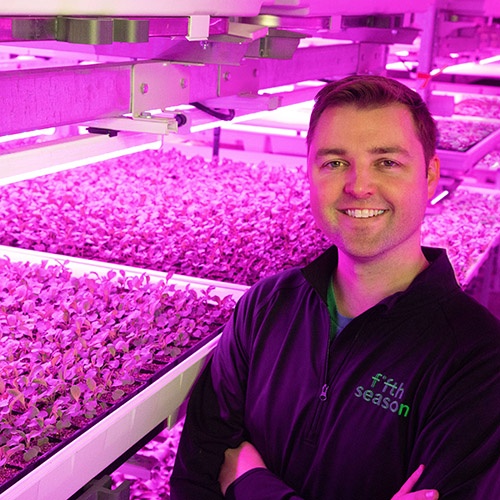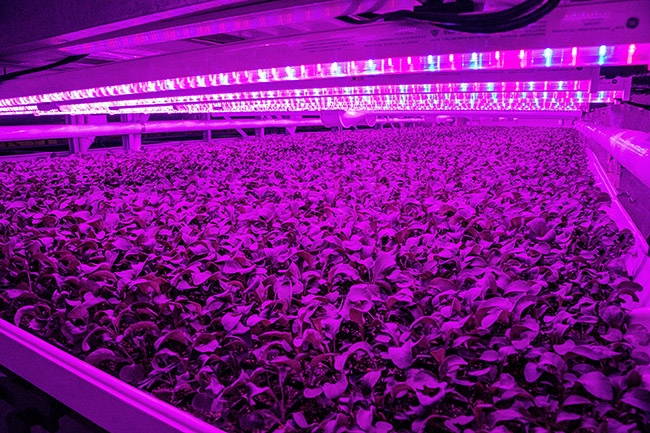
Fifth Season co-founders Brac Webb (left), Austin Lawrence and Austin Webb.
Photos by Tom O'Connor Photography and Jordon Rooney.
Fifth Season is a consumer-experience company that is using high-tech robotics and GE Current LEDs to produce leafy greens and herbs in a 60,000-square-foot vertical farm.
Case File Facts
COMPANY
Fifth Season
LOCATION
Pittsburgh, Pa.
CROPS
Leafy greens and herbs
TECHNOLOGY
High-tech robotics and GE Current Arize LED grow lights
BACKGROUND
Fifth Season, formerly RoBotany Ltd., was the brainchild of company co-founders Austin Webb, Brac Webb and Austin Lawrence. Founded in 2016, Austin Webb first met Lawrence at an entrepreneurship session at Carnegie Mellon University in Pittsburgh, Pa. Lawrence, who grew up on a blueberry farm and has a master’s degree in robotics, told Webb that he wanted to create a robotics system that would grow fresh produce in grocery stores. Austin Webb then asked his brother Brac to leave his IoT startup in California to join a well-rounded co-founding team. Although Fifth Season is not affiliated with Carnegie Mellon, the university has invested in the company and several of its employees are graduates of the school.
This team of entrepreneurs built a small version of their robotics farm in a conference room in the Oakland neighborhood of Pittsburgh. After receiving seed funding, the company relocated to a former steel mill on the south side of the city. The company converted 40,000 square feet of the building into a R&D space for robotics and plant growing.
When Fifth Season moved into the steel mill, the initial plan was to convert the entire facility into one large production farm. That plan was later changed to do a green field construction and build a new 60,000-square-foot vertical farm operation in the Pittsburgh borough of Braddock. Of the building’s total space, 25,000 square feet is being used for vertical farm crop production.
“Vertical farming is this wonderful solution to solve a lot of global food problems,” said Austin Webb, who is company CEO. “The problem is there is this industry-wide struggle to make the economics work. The vertical farm that we’ve built from the ground up is just the start in our journey to create a whole new era of fresh foods.”
Fifth Season produces an assortment of leafy greens, kale, arugula and herbs that is marketed to a local clientele including Giant Eagle and Whole Foods Market grocery stores along with numerous local restaurants.
Photo credits are Tom O'Connor Photography. Leafy greens (in white light) photo credit Jordon Rooney.

“Being able to bounce ideas off of Chris Higgins, Kyle Barnett and the Hort Americas team allowed us to push the boundaries of innovative thinking in terms of our approach and our technology in order to make vertical farming an economic reality today.”
– Austin Webb, co-founder and CEO, Fifth Season


CHALLENGE
Fifth Season’s new vertical farm facility is equipped with 40 different robots. The 25,000-square-foot grow room, which is equipped with GE Arize LED grow lights, has 12 levels with more than 125,000 square feet of production capacity.
“We started with a blank slate and designed our entire system from the ground up,” Webb said. “We designed this robotics system that is fully connected from end-to-end. There is an integration of robotics hardware and software so if we receive an order for spinach the system takes care of the rest.”
Webb said Fifth Season was inspired by the vegetable greenhouses in the Netherlands and the plant factories in Japan.
“We looked at those approaches and were definitely inspired by them,” Webb said. “Looking at vertical farming in North America and most of the world, we really saw these inefficient operations with a lot of labor. The cost of vertical farm labor was much more than the total costs of field production. There was a whole step-wise function of improvement to be made. We took a blank warehouse and designed it from seed to harvest to package.”
SOLUTION
Fifth Season has constructed a grow room that is automated to the point that humans don’t have to be in the room for the plants to enter, grow or exit. “We created the first human-free grow room that is very similar to automated fulfillment centers,” Webb said. “Instead of pallets of boxes, there are trays of plants which allow us to raise the bar on labor efficiency. People stay on the ground and don’t have to go up 30 feet high on scissor lifts to grab trays. We have been able to eliminate a lot of back-breaking manual labor.
“We have automated the entire production process from end-to-end where technically humans don’t need to be involved in the process. However, people are more efficient than robotics in some aspects including scouting crops, monitoring crop quality and performing quality assurance. We have 20-30 people inside the facility, including those who ensure the robots are working as planned.”
Fifth Season worked with Hort Americas to optimize how the robotics technology fit together with the science of growing plants.
“Hort Americas has been a great partner from the beginning,” Webb said. “Chris Higgins, Kyle Barnett and the Hort Americas team helped us validate our initial hypothesis of the specific challenges in making the economics work for vertical farms. Partnering together on our solution helped us validate that there was a path for our vertical farm to have favorable economics.”
Part of Fifth Season’s core values is to think differently.
“We don’t like the classic phrase 'That’s just the way it’s done,'” Webb said “But when thinking differently you want to avoid walking off a cliff. Being able to bounce ideas and technologies off of the Hort Americas team allowed us to push the boundaries of innovative thinking in terms of our approach and how we wanted to use technology to solve the complex issues that are limiting vertical farming. We were able to think differently, knowing we had the Hort Americas team as both a check and enabler, which ultimately created a successful collaboration.”
Another benefit of working with Hort Americas was the ability to partner with GE Current, a Daintree Company on its LED technology.
“We did a lot of things differently with our proprietary design and in so doing there were certain things that we couldn’t necessarily handle ourselves,” Webb said. “Working with Hort Americas and GE Current enabled us to move very quickly while making smart, capital-efficient decisions, as opposed to designing the LEDs ourselves or over-paying for unnecessary functionality.
“We worked with GE Current in key areas that made big differences related to the integration of our design. We leveraged GE Current's significant expertise in regards to light spectrum strategy and the corresponding impact on plant science and quality.”
BENEFITS
The vertical farm system designed and implemented by Fifth Season is an end-to-end solution. This covers everything from the processing to the final package, including seeding, growing, storage and plant retrieval. All of the activities related to growing plants, whether placing them in racks to grow or retrieving the plants for harvest, are automated.
“People are not touching the product,” Webb said. “The first person who actually touches the leafy greens or herbs is the consumer. In terms of the Fifth Season system, we have a lot less people than a traditional vertical farm and that is how we have been able to prove economic sustainability.
“Our proprietary system is efficient to the point where we are the only company in the vertical farm space that is competitive with field-grown product coming from western growers on an all-in cost basis. This starting point is only going to improve as we optimize our cost over time by combining our high resolution data, applied AI and knowledge of strategic partners such as Hort Americas.”
The benefits that Fifth Season has realized from its system include: growing with 95 percent less water, avoiding topsoil degradation, runoff pollution and pesticide applications, and reducing food waste.
“We can hyper-localize food production and distribution,” Webb said. “But all of these things can’t be achieved if we don’t have economic sustainability. That was our focus from the beginning and our commitment to profitability is what makes us different.”
For more: Fifth Season, hello@fifthseasonfresh.com; https://www.fifthseasonfresh.com.


You must be logged in to post a comment.